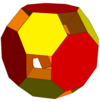Toroidal polytope
A toroidal polytope or toroid is an orientable polytope which is not homeomorphic to a hypersphere. Informally it is a polytope which has holes. All toroidal polytopes are nonconvex.
Like all polytopes, toroids are bounded by distinct vertices, edges, and other higher-dimensional elements. This, however, differentiates them from the torus that their name comes from, since the torus is a topological object that can be infinitely deformed while the toroids strictly adhere to the layout determined by their elements.
Toroidal polyhedra have been explored far more thoroughly than toroids in other dimensions. In 3 dimensions, an integer quantity called genus, written as g , can provide a more intuitive description of a toroid than the Euler characteristic does. For an orientable polyhedron, the genus can be determined by the relation and it directly corresponds to the number of "holes" in the toroid.
Non-self-intersecting polyhedra[edit | edit source]
Császár and Szilassi polyhedra[edit | edit source]

The Szilassi polyhedron consists of 7 irregular hexagonal faces, each of which shares an edge with all of the other faces. It is one of only two known polyhedra where any two given faces share an edge (the other one being the tetrahedron) and has the fewest faces of any toroid in 3D. Since it has 14 vertices and 21 edges, its genus is 1, which corresponds with it only having one "hole."
The dual of the Szilassi polyhedron is the Császár polyhedron. Being the Szilassi's dual, it has the fewest vertices of any toroid in 3D.
Stewart toroids[edit | edit source]

Stewart toroids are polyhedra of positive genus with regular faces, where no two faces that share an edge are coplanar, and where faces intersect only at edges.
Consideration of Stewart toroids may further be restricted to just those which are quasi-convex (they contain all the edges of their convex hull). While the set of Stewart toroids is infinite, it is believed that the set of just those which are quasi-convex is finite, albeit very large.
Many such polyhedra can be constructed by "excavating" one polyhedron from another (like the "diminishing" operation used in Johnson solids but without the restriction of convexity). Repeated excavations form "tunnels" passing through the faces of polyhedra and alter their genus.
| Toroid | Convex hull | Tunnel | Faces | Edges | Vertices | Genus |
|---|---|---|---|---|---|---|
 |
Truncated cube | 1 cube 2 square cupolae |
32 | 64 | 32 | 1 |
 |
Truncated cube | 1 cube 2 square cupolae |
32 | 64 | 32 | 1 |
 |
Truncated octahedron | 1 truncated tetrahedron 1 triangular cupola |
24 | 60 | 36 | 1 |
 |
Great rhombicuboctahedron | 1 small rhombicuboctahedron | 84 | 168 | 72 | 7 |
 |
Great rhombicuboctahedron | 1 small rhombicuboctahedron
12 cubes |
76 | 168 | 72 | 11 |
By connecting polyhedra face-to-face via the outer-blending operation (like the "augmenting" operation used in Johnson solids but without the restriction of convexity), a Stewart toroid may be created where a chain of connected polyhedra loops back on itself. The result will likely not be quasi-convex, but it may display a high degree of symmetry and can even have a regular or uniform convex hull.
Quadrilateral toroids[edit | edit source]

There exists an infinite family of toroidal polyhedra that are topologically equivalent to looped portions of the square tiling. They can be inscribed in a torus.
The vertex coordinates of an n-d toroid can be given by where and , and r is the major radius of the torus.
They can be uniform and noble (but also skew) when embedded in 4D space, as the honeycomb product of a n-gon and a d-gon, or equivalently as a subset of the faces of a n-d duoprism. If n=d, they are regular.
Self-intersecting polytopes[edit | edit source]

Uniform polytopes[edit | edit source]
Some uniform polytopes are nonconvex and have facets that intersect one another, causing their Euler characteristic to deviate from the usually-observed value in that dimension. While these polytopes may not appear to be toroidal, on an abstract level each one is topologically equivalent to a certain torus. For instance, the octahemioctahedron has Euler characteristic 0, making it equivalent to a genus-1 torus despite the fact that no hole is clearly visible in it.
Crown polyhedra[edit | edit source]
The crown polyhedra, also known as stephanoids, are polyhedra with butterflies for faces and vertex figures and the vertex layouts of various 3D prisms and antiprisms. They are noble and self-dual. Like the self-intersecting uniform polytopes, their Euler characteristic makes them topologically equivalent to certain tori.
See also[edit | edit source]
External links[edit | edit source]
- Doskey, Alex. "Toroidal Polyhedra".
- Doskey, Alex. "Adventures Among the Toroids - Index".
- Doskey, Alex. "After Stewart - Chapter 7 - Skeletons of Platonics and Archimedeans".
- Klitzing, Richard. "Finite Complexes".
- McCooey, David. "Non-Regular Toroidal Solids".
- McCooey, David. "Higher Genus Toroidal Solids".
- McNeill, Jim. "Toroids".
- Webb, Robert. "Miscellaneous Polyhedra (Stewart toroids)".
- Webb, Robert. "Stella: Polyhedron Navigator (Augmentation, excavation and drilling)".
- Wikipedia contributors. "Toroidal polyhedron".



